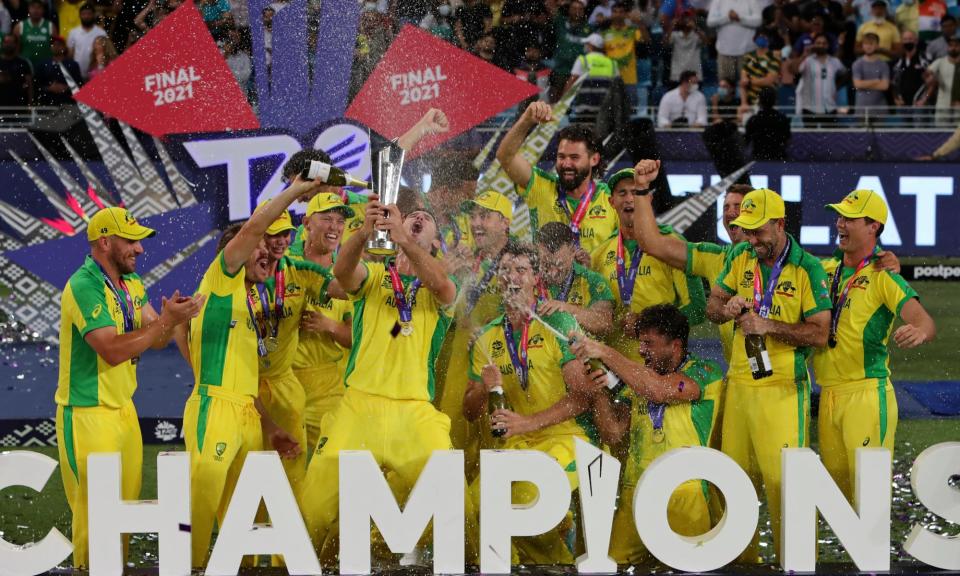India v Pakistan on Long Island? Why is the US hosting a Cricket World Cup?

So the US is hosting a World Cup of cricket? The game that takes five days to play, where they stop for sandwiches and cups of tea, and sometimes don’t even have a winner? Well, sort of. But you’re talking about Test cricket, which doesn’t have a World Cup, but sort of does in the form of the World Test Championship.
Got it. So this is the game that takes an entire day to play although, mercifully, you do usually get a winner? Well, sort of. But you’re talking about one-day cricket, which is played over the course of, appropriately, a day. That has its own World Cup, which takes place every four years, and next takes place in 2027.
Related: The Spin | ‘Land of opportunity’: USA is cricket’s bold new frontier once again
So what’s this World Cup then? And are tea and sandwiches involved? In the early 2000s, for the first time in its history, cricket was ahead of the curve. In a similar fashion to baseball in recent years, cricket executives started to fear that young people didn’t have the patience to sit through longer games without wandering off to do frivolous turn-of-the-millennium things like playing N64 or listening to 50 Cent (and this was before social media). The result was Twenty20, the shortest form of top-level cricket: games usually last around three hours rather than spanning several geological eras. And this upcoming World Cup is the Twenty20 World Cup (actually marketed as the T20 World Cup by people who presumably think anyone The Kids are incapable of relating to words of more than three letters)
Did the plan work?Well, in a way. Anyone who was reluctant to sit through five days of cricket before, was even less likely to do so once they could get a quick fix of the sport and still make it home in time for an N64 session before bedtime. That’s led to the decline of Test cricket, one of the finest products of the British empire. But seeing as the British empire also produced massive exploitation of countries and people around the world, maybe people aren’t that sad to see its dive in popularity. T20, meanwhile, has grown massively, particularly in India where the Indian Premier League generated more than $1bn in revenue last year (it’s the 13th most lucrative sports league in the world and growing fast). Critics of T20 say that players – who need to score runs as quickly as possible – have traded subtlety and craft for power in the same way that smallball gave way to an explosion of home runs in baseball. T20’s defenders say watching rotund men weakly pushing a ball around a field for days on end wasn’t that thrilling in the old days.
So, if cricket is associated with the British empire, why is this year’s T20 World Cup in the US? I thought we’d put an end to all this in 1776? Well, it’s actually being co-hosted by the US, along with the West Indies (a confederation of a dozen or so Caribbean nations who compete as one team in cricket). As for why – well, America does have a lot of money and, if local leagues can attract foreign superstars on short-term contracts, TV rights can be sold to the huge market in India. Whether that’s possible is debatable: various “foreign” sports, from rugby union and rugby league to something called “soccer” have attempted to get in on the lucrative US sports markets down the years, with varying degrees of success.
But cricket does have roots in the US: there are reports of matches played in America as early as 1751, and Philadelphia was a hotbed of the game until baseball consumed the country. And while it’s unlikely MLB and NFL fans are going to convert en masse to cricket, there are solid foundations. There are hundreds of thousands of American residents and citizens who grew up with the game in countries such as India, Pakistan, Australia, Bangladesh, England and Jamaica. And many of them passed their love of the game on to their US-born children.
Where will it be played? Most of the games, including the semi-finals and final will be played in the West Indies. But the US venues – in Grand Prairie, Texas; Lauderhill, Florida; and East Meadow, New York – will host 16 matches in total. Perhaps the most intriguing will be India v Pakistan on Long Island: think Yankees v Red Sox with added geopolitical tensions. Good luck getting tickets though: the cheapest are selling for $850 on resale sites. Tickets at more reasonable prices are available for most other games though.
Who’s going to win? Usual suspects like India, Australia, the West Indies and England are among the betting favorites but the team with the best winning percentage in the T20 World Cup is … Nepal?! Having said that, they have only appeared in the tournament once before – in 2014 – and won two of their three games, finishing second in their group and failing to progress. So maybe don’t bet your house/family/dog on them.
And the US? They’re actually not too bad! Many of their players grew up in traditional cricket-playing countries before switching allegiance to the US, but they’ve had solid results recently including victories over Canada, who they will play in the tournament opener and Bangladesh, who are ranked No 9 in the world.

